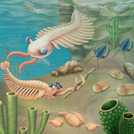
Cambrian explosion and biodiversity in the Phanerozoic Eon. Created by Sal Khan.
- Subject:
- Astronomy
- Physical Science
- Material Type:
- Lesson
- Provider:
- Khan Academy
- Provider Set:
- Khan Academy
- Author:
- Sal Khan
- Date Added:
- 01/20/2011

Cambrian explosion and biodiversity in the Phanerozoic Eon. Created by Sal Khan.

Biology is designed for multi-semester biology courses for science majors. It is grounded on an evolutionary basis and includes exciting features that highlight careers in the biological sciences and everyday applications of the concepts at hand. To meet the needs of today’s instructors and students, some content has been strategically condensed while maintaining the overall scope and coverage of traditional texts for this course. Instructors can customize the book, adapting it to the approach that works best in their classroom. Biology also includes an innovative art program that incorporates critical thinking and clicker questions to help students understand—and apply—key concepts.



By the end of this section, you will be able to:Describe the features that characterized the earliest animals and when they appeared on earthExplain the significance of the Cambrian period for animal evolution and the changes in animal diversity that took place during that timeDescribe some of the unresolved questions surrounding the Cambrian explosionDiscuss the implications of mass animal extinctions that have occurred in evolutionary history

This seminar will focus on dynamical change in biogeochemical cycles accompanying early animal evolution – beginning with the time of the earliest known microscopic animal fossils (~600 million years ago) and culminating (~100 million years later) with the rapid diversification of marine animals known as the “Cambrian explosion.” Recent work indicates that this period of intense biological evolution was both a cause and an effect of changes in global biogeochemical cycles. We will seek to identify and quantify such coevolutionary changes. Lectures and discussions will attempt to unite the perspectives of quantitative theory, organic geochemistry, and evolutionary biology.
